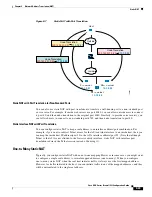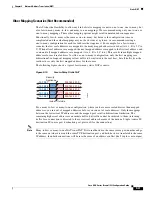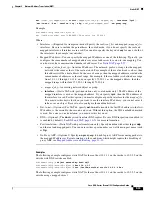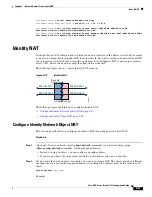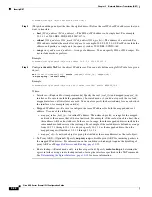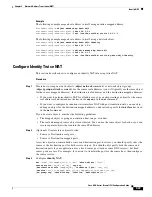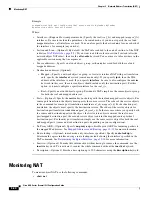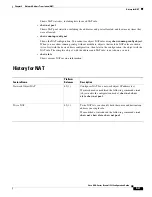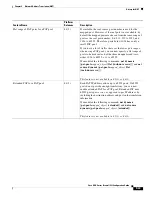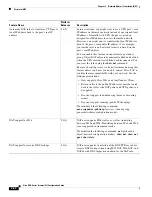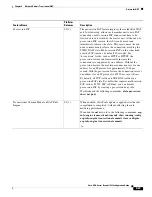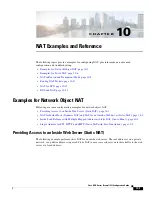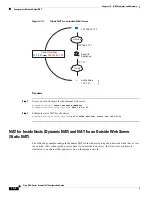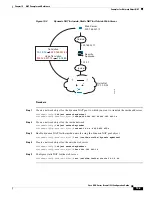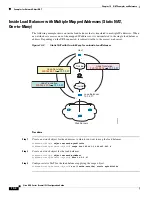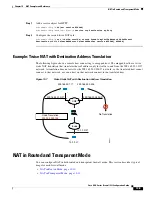
9-40
Cisco ASA Series Firewall CLI Configuration Guide
Chapter 9 Network Address Translation (NAT)
Monitoring NAT
Example
hostname(config)# nat (inside,outside) source static MyInsNet MyInsNet
destination static Server1 Server1
Where:
•
Interfaces—(Required for transparent mode.) Specify the real (
real_ifc
) and mapped (
mapped_ifc
)
interfaces. Be sure to include the parentheses. In routed mode, if you do not specify the real and
mapped interfaces, all interfaces are used. You can also specify the keyword
any
for one or both of
the interfaces, for example (any,outside).
•
Section and Line—(Optional.) By default, the NAT rule is added to the end of section 1 of the NAT
table (see
). If you want to add the rule into section 3 instead (after the
network object NAT rules), then use the
after-auto
keyword. You can insert a rule anywhere in the
applicable section using the
line
argument.
•
Source addresses—Specify a network object, group, or the
any
keyword for both the real and
mapped addresses.
•
Destination addresses (Optional):
–
Mapped—Specify a network object or group, or for static interface NAT with port translation
only, specify the
interface
keyword (routed mode only). If you specify
ipv6
, then the IPv6
address of the interface is used. If you specify
interface
, be sure to also configure the
service
keyword (in this case, the service objects should include only the destination port). For this
option, you must configure a specific interface for the
real_ifc
.
–
Real—Specify a network object or group. For identity NAT, simply use the same object or group
for both the real and mapped addresses.
•
Ports—(Optional.) Specify the
service
keyword along with the real and mapped service objects. For
source port translation, the objects must specify the source service. The order of the service objects
in the command for source port translation is
service
real_obj mapped_obj
. For destination port
translation, the objects must specify the destination service. The order of the service objects for
destination port translation is
service
mapped_obj real_obj
. In the rare case where you specify both
the source and destination ports in the object, the first service object contains the real source
port/mapped destination port; the second service object contains the mapped source port/real
destination port. For identity port translation, simply use the same service object for both the real
and mapped ports (source and/or destination ports, depending on your configuration).
•
No Proxy ARP—(Optional.) Specify
no-proxy-arp
to disable proxy ARP for incoming packets to
the mapped IP addresses. See
Mapped Addresses and Routing, page 10-12
for more information.
•
Route lookup—(Optional; routed mode only; interfaces specified.) Specify
route-lookup
to
determine the egress interface using a route lookup instead of using the interface specified in the
NAT command. See
Determining the Egress Interface, page 10-14
for more information.
•
Inactive—(Optional.) To make this rule inactive without having to remove the command, use the
inactive
keyword. To reactivate it, reenter the whole command without the
inactive
keyword.
•
Description—Optional.) Provide a description up to 200 characters using the
description
keyword.
Monitoring NAT
To monitor object NAT, use the following commands:
•
show nat
Summary of Contents for ASA 5508-X
Page 11: ...P A R T 1 Access Control ...
Page 12: ......
Page 157: ...P A R T 2 Network Address Translation ...
Page 158: ......
Page 233: ...P A R T 3 Service Policies and Application Inspection ...
Page 234: ......
Page 379: ...P A R T 4 Connection Management and Threat Detection ...
Page 380: ......




